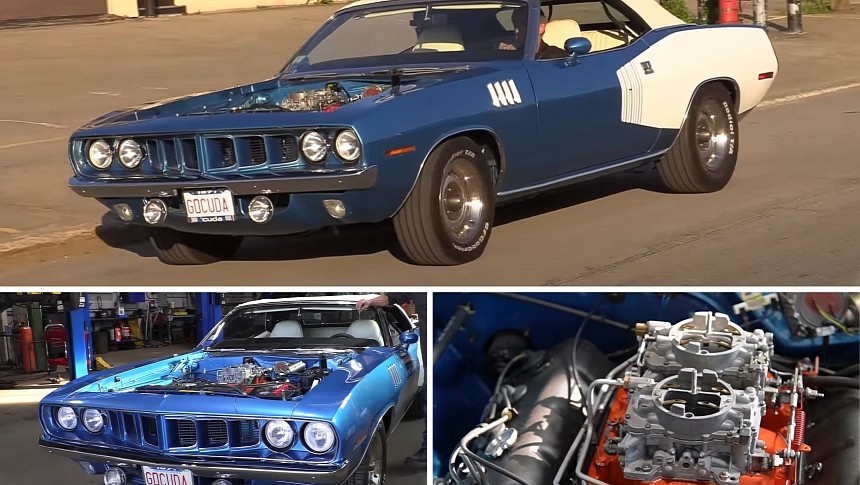Arguably Chrysler's most iconic engine, the 426-cubic-inch (7.0-liter) HEMI was produced from 1964 to 1971. Originally introduced as a race-spec engine for NASCAR duty, it gained a streetable version for homologation purposes. The latter arrived in 1966.
The street HEMI was similar to the race mill, but it featured an inline 2x4-barrel induction system, a lower compression ratio, a lower-lift camshaft, and iron exhaust manifolds. Rated at 425 horsepower and 490 pound-feet (664 Nm) of torque, it was among the most potent engines of the golden muscle car era.
It found its way in various Mopars, starting with the Dodge Charger and Coronet and the Plymouth Belvedere and Satellite. In 1967, Plymouth also offered it in the GTX. The Dodge Super Bee and Plymouth Road Runner also joined HEMI ranks in 1968, when the Dart and Barracuda got it in limited-edition Super Stock versions. The availability of the 426 HEMI expanded to the Dodge Charger Daytona in 1969 and the Plymouth Superbird and Dodge Challenger in 1970.
That's quite a long list of cars, I know, but this doesn't mean that HEMI-powered Mopars are easy to come by today. Chrysler reportedly built only about 11,000 engines, but it's unclear how many of them left the factory in street spec. All told, HEMI cars are rare and expensive nowadays, especially Mopars built in the early 1970s when the looming oil crisis and high insurance rates rendered the 426 unpopular.
The Plymouth HEMI 'Cuda is a good example of how HEMI sales collapsed dramatically in just a year. With 666 units moved in 1970, the HEMI 'Cuda found only 114 customers in 1971, the engine's final year on the market. The convertible variant is even rarer, with only 14 units made in 1970 and just seven sold in 1971. And not only seeing a HEMI drop-top in the metal is an unlikely event, but buying one will set you back millions of dollars. For instance, a pristine 1971 example failed to sell for a whopping $4.8 million in 2021.
With HEMI 'Cuda prices now going into 1960s Ferrari territory, it's unsurprising that many enthusiasts opt to build replicas. And while some of them are easy to spot, others look impressively authentic, even upon close inspection. The blue 1971 example you see here is one of those cars.
Showcased by "Nick's Garage," the 'Cuda dropped by the shop for an engine rebuild. There's no info on what mill it got from the factory, but the convertible proudly displays a 426 HEMI behind the color-keyed grille. The mill mates to a Tremec five-speed manual, so the drivetrain combo isn't exactly period correct, but the V8 feels authentic and sounds as it should.
And needless to say, the car looks fantastic inside and out, and the color combination is as appealing as they get. The metallic blue work great with the white billboard stripes and matching soft top, and the interior also provides a cool contrast in black and white. It's a show-stopper and I wouldn't be surprised to hear it wins a few awards once it hits the classic car show circuit. Check it out in the video below. The Mopar pops up at the 8:00-minute mark.
It found its way in various Mopars, starting with the Dodge Charger and Coronet and the Plymouth Belvedere and Satellite. In 1967, Plymouth also offered it in the GTX. The Dodge Super Bee and Plymouth Road Runner also joined HEMI ranks in 1968, when the Dart and Barracuda got it in limited-edition Super Stock versions. The availability of the 426 HEMI expanded to the Dodge Charger Daytona in 1969 and the Plymouth Superbird and Dodge Challenger in 1970.
That's quite a long list of cars, I know, but this doesn't mean that HEMI-powered Mopars are easy to come by today. Chrysler reportedly built only about 11,000 engines, but it's unclear how many of them left the factory in street spec. All told, HEMI cars are rare and expensive nowadays, especially Mopars built in the early 1970s when the looming oil crisis and high insurance rates rendered the 426 unpopular.
The Plymouth HEMI 'Cuda is a good example of how HEMI sales collapsed dramatically in just a year. With 666 units moved in 1970, the HEMI 'Cuda found only 114 customers in 1971, the engine's final year on the market. The convertible variant is even rarer, with only 14 units made in 1970 and just seven sold in 1971. And not only seeing a HEMI drop-top in the metal is an unlikely event, but buying one will set you back millions of dollars. For instance, a pristine 1971 example failed to sell for a whopping $4.8 million in 2021.
With HEMI 'Cuda prices now going into 1960s Ferrari territory, it's unsurprising that many enthusiasts opt to build replicas. And while some of them are easy to spot, others look impressively authentic, even upon close inspection. The blue 1971 example you see here is one of those cars.
Showcased by "Nick's Garage," the 'Cuda dropped by the shop for an engine rebuild. There's no info on what mill it got from the factory, but the convertible proudly displays a 426 HEMI behind the color-keyed grille. The mill mates to a Tremec five-speed manual, so the drivetrain combo isn't exactly period correct, but the V8 feels authentic and sounds as it should.
And needless to say, the car looks fantastic inside and out, and the color combination is as appealing as they get. The metallic blue work great with the white billboard stripes and matching soft top, and the interior also provides a cool contrast in black and white. It's a show-stopper and I wouldn't be surprised to hear it wins a few awards once it hits the classic car show circuit. Check it out in the video below. The Mopar pops up at the 8:00-minute mark.










